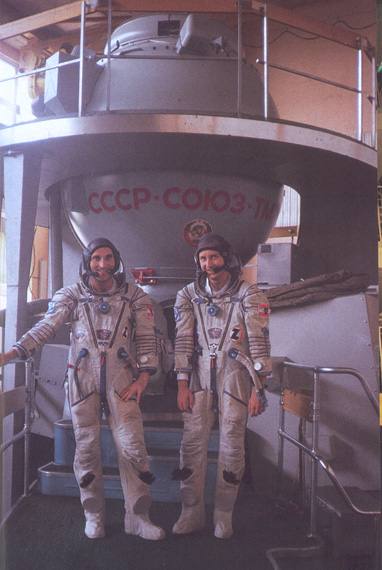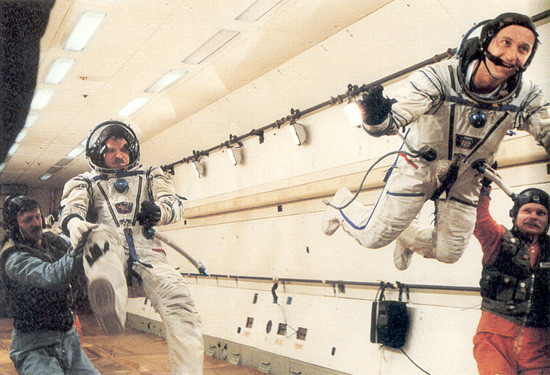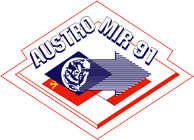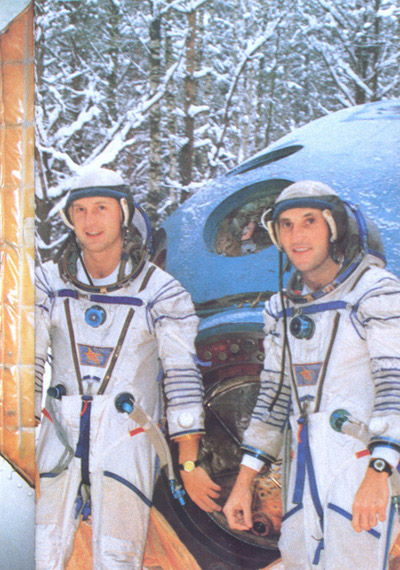Personally impressions of the Austrian Cosmonauts
Dr. Clemens Lothaller and Dipl.-Ing. Franz Viehboeck (May 1991)
From 8 January we have been living in Star City, the Soviet training center for Cosmonauts. This little city has about 3000 residents and was build up about 40 km northeastern from Moskau in a military area 30 years ago. The sourrounding forests keeps away most of the detrimental effects on the environment from the metropolis Moskau and we don`t perceive them. In the immediate vicinity is ab big military airport with brisk airtraffic even in the night.
The Star City is cut in the residential quarter and the training area. In this you can find the simulators for the transport space ship Sojus, the training model of the space station MIR, a big tank for the under-water-training of the Extra Vehicular Activity (EVA), the human centrifuge, the stadia and the office buildings for the doctors, engineers and other specialists.
The residental Quarter includes a cinema, three lakes and big forests for recovery. Here live among the Cosmonauts the engineers, medical stuff, teachers and the other staff included in the trainings programm of the Cosmonauts. Foreign persons and the expert Cosmonauts are living in two sperate apartment houses with bigger and more comfotable apartements. We have been living in these houses in common with many famouse Cosmonauts like Alexej Leonov, the first man that made an Extra Vehicular Activity (EVA) or Valentina Tereschkova, the first woman in space. Even the family of Juri Gagarin, the first man in space, is still living here. Our apartments had about 70 m2 and included three rooms, a kitchen, bathroom, toilet and two balconies. These flats are for Soviet circumstances absolute luxury. The city has got four different shops for catering, in those the residents can go for shopping depending on their military grade or position. And like the priority of the shop was its accouterment with products. Fortunately the foreign Cosmonauts and their Soviet collegues had been categorised in the highest class, so the catering was no problem for us. But even we had problems to get food in these shops during bad times. Our back-door had been two device supermarkets in Moskau and the products we got from our home countries.
Our training started immediately after our arrival in Baikonur. At 7.00 a.m. the daily program started with 45 minutes sport. From 9.00 a.m. to 6.00 p.m. we had the different training units with 1 hour midday break. In the beginning we had to eat our lunch in the Cosmonauts canteen, but when some time went by our doctors allowed us to eat our lunch at home. We prevered eating at our apartements because it was very hard for us to cope with the bad catering for the residents.
Every second day we had a two hour unit of sport. A high value was set on physical activities during the training, so we had very good conditions to stay physical fit. In the training area we had a fitness center, a sauna, an in- and outdoor tennis court and a football asset. Our program was composed by a trainer and includes endurance training like running or cross-country skiing as well as weight training or games and of course special trainings for the space flight. This special training included training with the trampoline and special gymnastic exercises for the equilibrium organ. The movement of the body fluids in the head from the weightlessness during the first days in space cause bad headache. So we trained our circulation and the vessels in the upper part of our bodies lying head first on a pendular couch. Our condition was checked quaterly from the trainer, so that he was able to adapt our training program.
The first four months we learned Russian with a teacher from the university, because the understanding of the Russian language was the requirement for the further lessons, which had all been taught in Russian. We had eight lessons Russian during the day and in the evening we had a lot to do with learning vocabularies. In this time we nearly didn`t have any leisure time. After this intensive course the amount of lessons was reduced and the theoretical courses started.
We heard a lot about the restrains of the human organism at different pressure- and oxygencircumstances, the space sickness, the problems of the human organism in weightlessness, the radiation on the space station and the physiological aspects of a space flight in cosmic medicine. In Flight theory we learned about the procedures of a space flight from lift off, changing of the orbit, andocken on the space station to the landing. In the beginning we had some problems to understand the conditions in space. The fact, that an accelerating space ship slows down we really had to rack our brains on it. In the lessons about the control system we learned about the different ways to navigate the space ship and the space station.
At the end of each subject we had to take an exam at an examamination board. It was a strange feeling for us standing in front of an examination board with 13 members twosome. These exams were followed from applied lectures, during those we trained with the training units and simulators for the space station MIR and the space transporter Soyuz.
Initially we learned about the detailled assembly and the single elements of the space station and the space ship. We had to know where which parts were, from which control panel the different orders had to be given and how the electric power supply and the heat regulation worked. We had to be able to establish a radio or broadcasting contact with the control center ourselves.
The most importance was attached to the life support system. We learnded detailed the function of the oxygen and water supply system and how the supply with aliments worked. Another very important point were the sanitary facilities; those had to be conceived for the conditions in weightlessness. Even the simple handwashing caused many problems, because we didn`t have running water like we have it in mind. Water in weightlessness accumulates to big drops, which float around in the room.
To cope with the important systems we had to absolve many examples of different situations in the simulators. In autumn 1990 we had exams nearly every week, so that we only had very few leisure time for us. In January 1991 we completed the theoretical training and started the practical training with the simulators and the Austrian experiments. As from June to September we trained together with the Soviet crew. The situations of lift off, the space flight itself and the landing were run through many times in the simulators as well as different emergency situations.


In the beginning of September the knowledge and skills of all crew members were checked in a final examination through a public comission. During the training we had to absolve many other trainings, that should give us more practise in emergency situations, too. For example, we had to do drops and survival trainings in winter at minus 15° C. We were brought into the woods with the landing capsule and had to survive only with the emergency ration food and water and the tools on board for two days. We also had to get used to the helicopter rescue from water and land and made a special survival training at the sea. On shedule the Soviet landing capsule should be landing on land with parachute and retrorockets. In preparation for weightlessness we flew with special adapted airplanes socalled parable flights. Those airplanes can follow a parabolic trajectory for about 25 seconds, during this time one is in weightlessness. One flight included ten Parables, during those we trained with special coordination exercises and trained to dress and to remove the spacesuit.
As health is a very important factor for a Cosmonaut we were currently examined medical. Every third month we had to do our visits at all medical specialists and each year we had to absolve a big medical check with centrifugal tests, tests in the low pressure chamber and on the Drehstuhl. After the finish of all these tests an own medical comission certivicates ones fitness to get a Cosmonaut.
In the middle of September we went on vaccation for one week together with the other crew, and two weeks before the lift off we visited the launch area in Baikonur, where the lift off of Soyuz TM-13 should occur.


